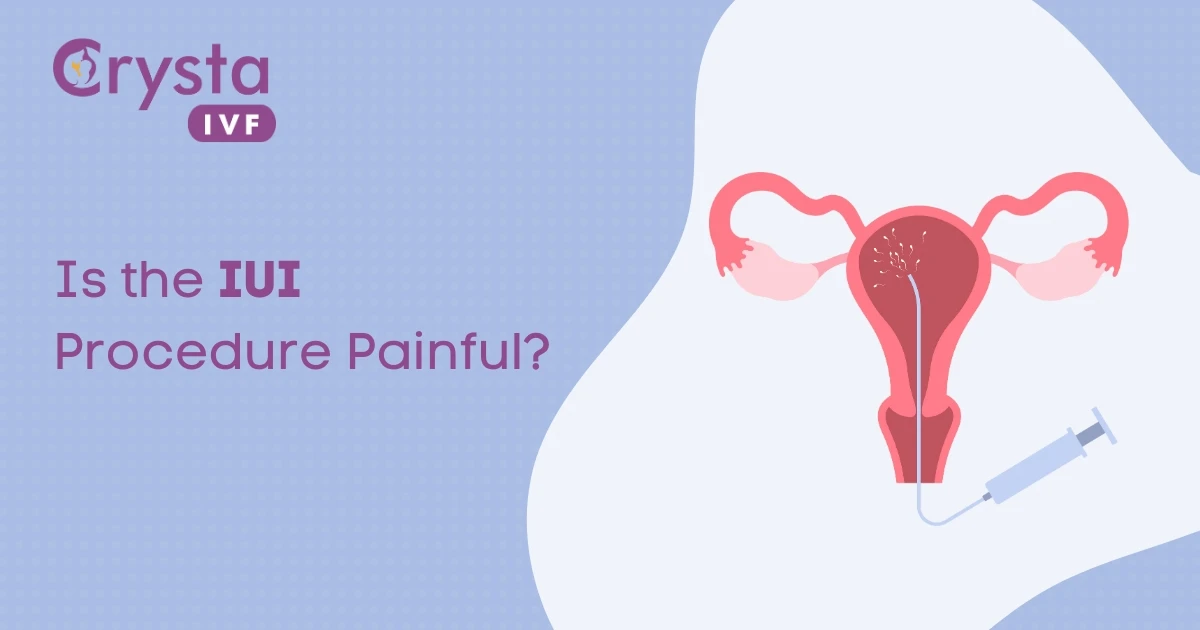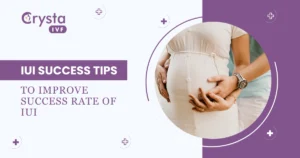
Medically Reviewed By
Dr. Nidhi Sehrawet

People with fertility challenges are still hoping for a miracle to change their lives and to conceive a child. Thanks to world-class technology and its involvement in healthcare, assisted reproductive technology and its popular form – Intrauterine Insemination IUI Treatment have helped many people overcome their reproductive issues and plan healthy babies.
Though the IUI procedure gives couples an advantage, many people have this concern – “Is IUI Process Painful?”
So, here we will dig deeper to learn the truth about IUI pain and debunk its common misconceptions to give a clear perspective to couples who want to overcome all obstacles. So scroll down, and let’s get started, but first, let’s understand what IUI treatment is.
The Basics of IUI Treatment
Intrauterine Insemination (IUI), a type of artificial insemination, is a fertility treatment where the sperm is placed directly into a person’s uterus.
During natural conception, sperm travels from your vagina through your cervix into your uterus and fallopian tubes.
Once your ovary releases an egg, it travels to your fallopian tube. At this point, the sperm and egg meet, and the fertilization process occurs.
During the IUI procedure, the sperm is collected, washed, and concentrated so that only high-quality sperm gets collected. The selected sperm is placed into your uterus with a catheter (a thin tube), keeping it closer to your fallopian tubes.
The IUI procedure makes it easier for the sperm to reach an egg because it shortens the time and distance. In short, the IUI process boosts your likelihood of getting pregnant successfully. Now, let’s understand step by step if the IUI procedure is painful.
Also Read – IUI Treatment in Hindi?
Is the IUI process painful?
To think about whether the IUI is painful or not, the answer would be partially positive. When the sperm is placed into the uterus for the first time, many individuals may experience severe discomfort.
Still, women undergoing IUI treatment should know it is unnecessary to be sedated or take painkillers during IUI because it is a minimally intrusive procedure.
The ideal time to perform IUI treatment is when you are expected to ovulate. The procedure involves directly injecting the sperm cells into the uterus to facilitate the sperm’s proximity to the eggs.
Some women may also feel minor pinching and mild cramping when the catheter is inserted through the cervix. But as the catheter goes into the cervix, the discomfort starts troubling you more and more. Even doctors agree that patients suffer discomfort throughout the operation.
However, if the sensation intensifies or becomes unpleasant, it is suggested that patients immediately inform their healthcare provider and contact them for consultation.
Even after the treatment, it is quite common to suffer cramps or minor bleeding. Ovulation causes cramps, especially if the patient uses an ovulation suppressant. Pain decreases after the catheter is withdrawn. If the tube scratches, it doesn’t fall into the danger category.
Hence, saying the IUI process is painful may not be accurate, especially when you have analyzed the vital factors yourself. Moreover, it must be noted that, after the execution of IUI treatment, some women might suffer cramping due to their inflamed uterus.
After debunking the myth, let’s look at how long it takes to complete the IUI procedure.
Related – How IUI treatment can boost your chances of a successful pregnancy?
How long the IUI procedure takes place: A step-by-step analysis
The IUI procedure typically involves several steps and depends on an individual’s health condition. For your help, we have curated an analysis of the IUI procedure step-by-step –
- Initial consultation The first step is to schedule an initial consultation with a fertility expert to determine your reproductive health status.
- Ovarian stimulation: In some instances, your doctor will recommend ovarian stimulation to enhance your chances of getting success in IVF.
- Monitoring: During the entire ovarian stimulation phase, you will be monitored through blood tests and ultrasound. This will assist your doctor in tracking the follicle’s development and measuring hormone levels to determine the optimal time for insemination.
- Trigger shot: Your doctor may administer a trigger shot when the follicles reach their desired size. This injection contains human chorionic gonadotropin (hCG), which helps in the maturation of the eggs and triggers their release from the follicles.
- Sperm Collection: On the insemination day, your partner or a sperm donor will provide a semen sample at the fertility centre, from which the healthiest one will be selected to improve your chances of success.
- Insemination: After the semen sample is processed, there are significant proceedings in the IUI procedure. The procedure is relatively simple and painless. In this, sperm are injected directly into the uterine cavity so that fertilization can occur smoothly.
- Post-Insemination: Following the IUI procedure, you will be asked to rest briefly before you go home. And after waiting a couple of weeks, you can take a pregnancy test.
Also Read – What is the success rate of IUI?
Who is a Candidate for IUI treatment?
IUI is typically performed when your partner’s sperm count is poor, or his sperm motility is insufficient. In addition, IUI treatment is also recommended in the following cases:
- Undiagnosed infertility
- Very mild endometriosis
- Same-sex couples
- Males with deficient sperm
- Men having trouble getting an erection or ejaculating
- For couples who do not want to pass their male partner’s genetic abnormalities on to their unborn child
- Mucous issues in the cervical region, or cervix
If you have any listed complications or other fertility issues, you should talk to your doctor. Also, look at who should avoid IUI treatment for a better understanding.
Who should not opt for IUI treatment?
Suppose you have any of the listed complications or other fertility issues. In that case, it is better to talk to your fertility doctor and understand how you can overcome these obstacles that stand in your way of conceiving a healthy baby.
Also, women with damaged or blocked fallopian tubes cannot release eggs. Hence, they are unsuitable for IUI treatment, along with those with pelvic infections. For such cases, (In vitro fertilization) IVF treatment is generally recommended.
Learn more about IVF treatment here – In Vitro Fertilization (IVF) Treatment In India, Crysta IVF
So what should be the right choice? Are you suitable for intrauterine insemination or not? The answers to all your questions can only be found by consulting with a fertility specialist.
A Word From Crysta IVF
Intrauterine insemination (IUI) is considered the best option for couples experiencing fertility issues. Still, it is best to consult an experienced fertility specialist at the best fertility clinic in delhi at Crysta IVF.

As we have studied, IUI treatment is not suitable for women having complications with their fallopian tubes or pelvic infections. So, before making up your mind, reach out to Crysta IVF for right guidance and treatment.
The fertility experts will ensure you get a personalized approach to discussing all your fertility issues without having any doubt, along with discussing other health-related problems, so the likelihood of success in IUI treatment can be increased.




